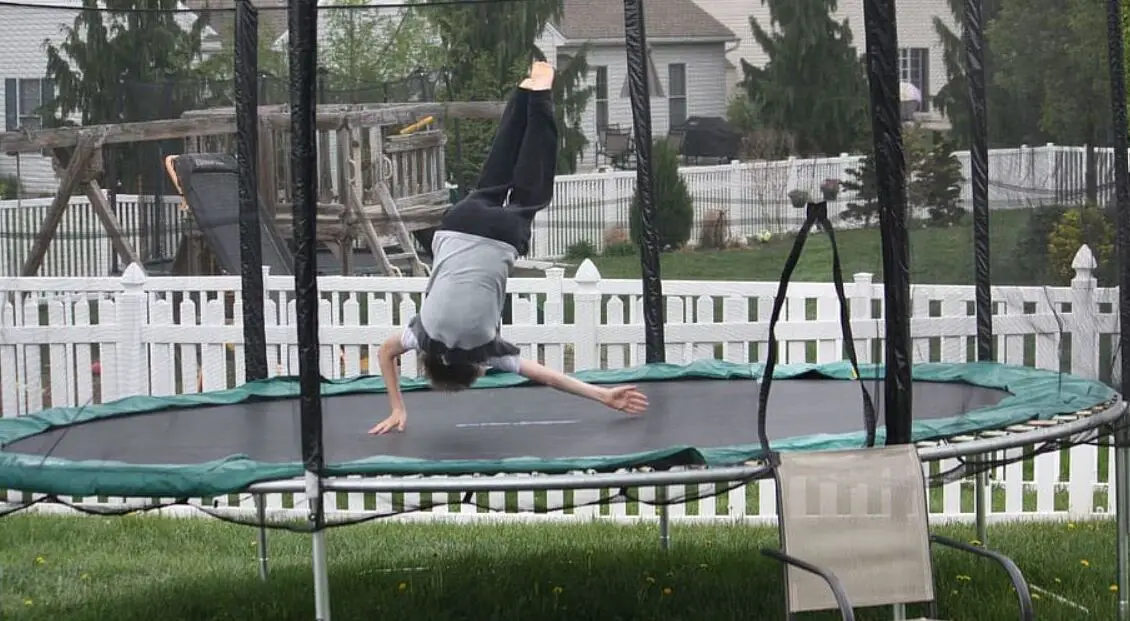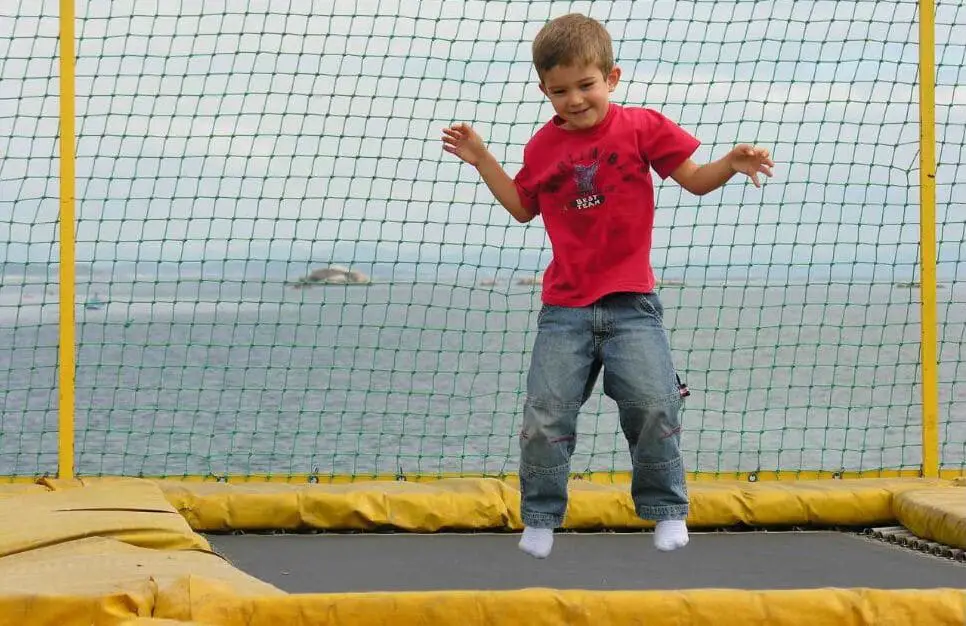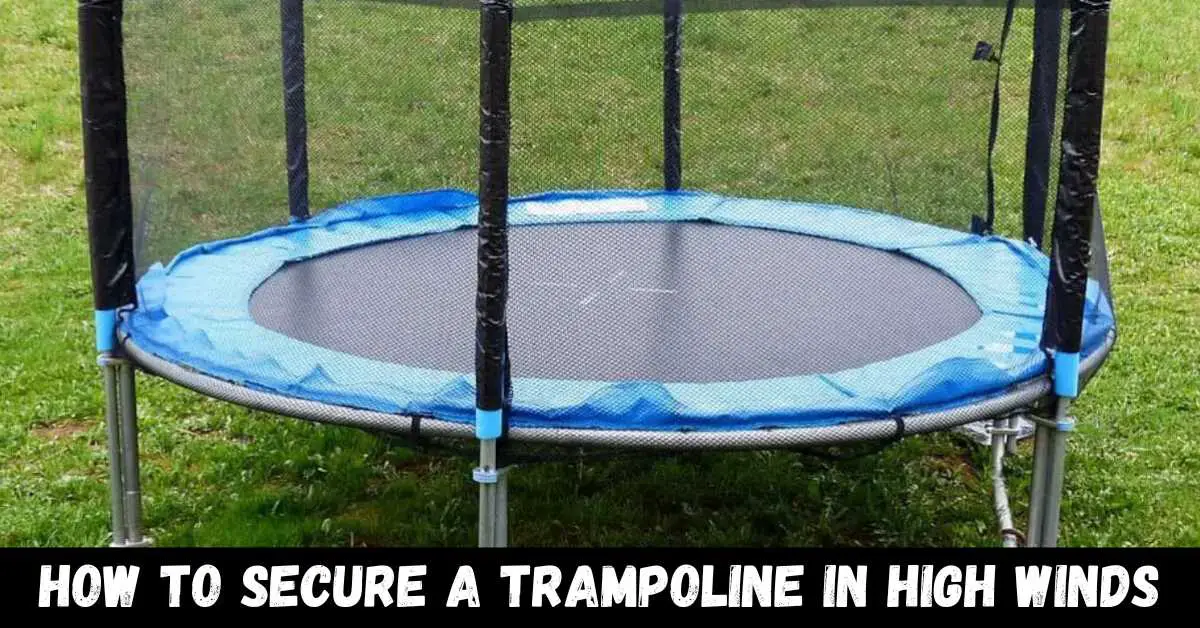I know how important it is to make sure it’s securely anchored in high winds. To keep my trampoline from tipping over or flying away during strong gusts, I follow a few simple steps.
First, I make sure the trampoline is situated in an open area without any nearby obstacles or hazards that could damage it. Then, I use sturdy metal stakes or anchors to secure the legs of the trampoline to the ground.
These stakes should be driven into the soil or grass at a 45-degree angle and be at least 12 inches long to provide maximum stability.
Additionally, I always remove the safety netting and padding from the trampoline during high winds to prevent it from acting as a sail and causing the trampoline to tip over.
Finally, I regularly inspect the trampoline for any signs of wear or damage, such as rusted metal or torn fabric, and replace any worn-out parts as needed.
By taking these precautions and securing my trampoline properly, I can enjoy bouncing and jumping without worrying about my safety or the safety of others during high winds.
How to secure a trampoline in high winds: To secure a trampoline in high winds, start by removing any accessories, such as a safety net or ladder. Then, use strong, heavy-duty stakes to anchor the legs of the trampoline to the ground. Alternatively, you can use sandbags or cinder blocks to weigh down the legs. Finally, cover the trampoline with a weather-resistant cover to protect it from the wind.
How To Secure A Trampoline In High Winds?
If you have a trampoline, it’s important to secure it during high winds to prevent it from being blown away and causing damage or accidents. There are different ways to secure a trampoline, such as using tie-down kits or bungee cords, as well as other methods like sandbags or stakes.
It’s recommended to regularly check the ties and cords of your trampoline, especially during windy seasons. In case of extreme weather conditions, it’s best to take down or store the trampoline to ensure everyone’s safety.
If you need to dismantle parts of your trampoline, follow the manufacturer’s instructions and properly store the dismantled parts.
Assessing the Risk of Damage Caused by High Winds to Your Trampoline
Trampolines can provide hours of fun and entertainment for children and adults alike, but they can also pose a safety hazard during stormy weather. High winds can cause trampolines to become airborne, leading to damage to property and injury to people.
Therefore, it is essential to assess the risk of damage caused by high winds to your trampoline and take action beforehand. This article will explain how to assess the risk of damage and the importance of staying updated with weather reports.
Assessing the Risk
Before assessing the risk of damage caused by high winds to your trampoline, it is important to understand the factors that can affect its stability. These include the size and weight of the trampoline, the height and strength of its enclosure, and the quality and strength of its components.
Additionally, the location of the trampoline is also a crucial factor to consider. A trampoline placed in an open area with no protection from wind or shelter is more vulnerable to damage.
Once you have assessed these factors, you can then determine the level of risk your trampoline is at during high winds. There are several ways to do this. Firstly, you can consult your trampoline’s manufacturer guidelines to determine its wind rating.
This rating indicates the maximum wind speed that your trampoline can withstand before it becomes unsafe. If your trampoline has a low wind rating, it is more vulnerable to damage during high winds.
Another way to assess the risk is to observe the weather conditions. Check the wind speed and direction before setting up your trampoline. If the wind speed is high or gusty, it is best to avoid using the trampoline altogether.
If you have already set up the trampoline, it is best to dismantle it temporarily or secure it to the ground to prevent it from becoming airborne.
The Importance of Staying Updated with Weather Reports

Staying updated with weather reports is essential when it comes to assessing the risk of damage caused by high winds to your trampoline. Weather conditions can change rapidly, and it is crucial to stay informed about the latest updates.
Check weather reports regularly and keep an eye out for warnings of high winds or severe weather conditions.
If you live in an area prone to severe weather, consider investing in a weather monitoring system. This system can alert you to potential risks, allowing you to take appropriate action beforehand. You can also set up alerts on your phone or other devices to receive weather updates in real-time.
Taking Action Beforehand
Taking action beforehand is crucial when it comes to protecting your trampoline from damage caused by high winds. There are several steps you can take to prepare your trampoline for severe weather conditions. These include:
Disassemble your trampoline – If you know that high winds are on the way, it is best to disassemble your trampoline and store it in a safe place. This will prevent it from becoming airborne and causing damage.
Secure your trampoline to the ground – If you cannot disassemble your trampoline, it is important to secure it to the ground using stakes or anchors. This will provide stability during high winds and prevent it from being blown away.
Remove the enclosure – If your trampoline has an enclosure, consider removing it temporarily during high winds. This will reduce the wind resistance and prevent the trampoline from becoming airborne.
Preparing Your Trampoline: Disassembling, Storing, and Securing
If you own a trampoline but won’t be using it for an extended period, it’s essential to take some necessary steps to ensure its longevity and safety.
Disassembling and storing it correctly, as well as securing it to the ground, can help prevent damage caused by weather and other environmental factors.
we will guide you on how to prepare your trampoline for long-term storage by disassembling and storing it correctly and securing it to the ground using stakes or anchors.
Disassembling and Storing Your Trampoline
Disassembling your trampoline is a crucial step in preparing it for long-term storage. It’s essential to follow the manufacturer’s instructions carefully to avoid damaging the trampoline during the disassembly process.
Here are some general steps you can take to disassemble and store your trampoline safely:
Remove the net enclosure – Start by removing the net enclosure, if your trampoline has one. This will make it easier to access the springs and mat.
Remove the springs – Use a spring removal tool to remove the springs from the frame. Be sure to remove all the springs from one side of the frame before moving on to the other side.
Remove the mat – After removing all the springs, carefully remove the mat from the frame. Fold it neatly and store it in a dry, cool place.
Disassemble the frame – Once the mat is removed, disassemble the frame by taking it apart in sections. Use a wrench to loosen the bolts and nuts holding the frame together. Be sure to label and store the parts carefully to make it easier to reassemble the trampoline later.
Store the trampoline – Once the trampoline is disassembled, store it in a dry, cool place away from direct sunlight. Cover it with a tarp to protect it from dust and other environmental factors.
Securing Your Trampoline to the Ground

If you live in an area with high winds or other severe weather conditions, securing your trampoline to the ground is crucial to prevent it from becoming airborne and causing damage or injury. Here’s how to secure your trampoline to the ground using stakes or anchors:
Purchase stakes or anchors – To secure your trampoline to the ground, you’ll need to purchase stakes or anchors designed specifically for trampolines. You can find these at most hardware stores or online.
Position the stakes or anchors – Position the stakes or anchors around the base of the trampoline frame, spaced evenly apart. Make sure the stakes or anchors are deep enough to provide stability during high winds.
Secure the stakes or anchors – Attach the stakes or anchors to the frame of the trampoline using the manufacturer’s instructions. Be sure to tighten them securely to ensure the trampoline is firmly anchored to the ground.
Check the stability – Once the stakes or anchors are securely attached, test the stability of the trampoline by pushing it from different directions. If it feels wobbly or unstable, adjust the stakes or anchors until it feels secure.
Securing Your Trampoline During High Winds
Trampolines are a fun way to get exercise and enjoy the outdoors, but they can also pose a danger during high winds. To ensure the safety of your trampoline and those who use it, it’s important to properly secure it during inclement weather.
we’ll discuss how to use trampoline tie-down kits or bungee cords to secure your trampoline during high winds, as well as how to dismantle parts of your trampoline if necessary.
Trampoline Tie-Down Kits
Trampoline tie-down kits are designed to secure trampolines during high winds, reducing the risk of the trampoline becoming airborne and causing damage or injury.
These kits typically include straps or cables that attach to the frame of the trampoline and secure it to the ground using stakes or anchors.
Explanation of what a trampoline tie-down kit is
A trampoline tie-down kit is a set of straps or cables that are used to secure the trampoline to the ground. The kit usually includes stakes or anchors that are driven into the ground and used to anchor the straps or cables to prevent the trampoline from being lifted in high winds.
Step-by-step instructions for using a trampoline tie-down kit to secure a trampoline
- Begin by selecting a suitable location for your trampoline. Ideally, the location should be on level ground and away from any obstacles such as trees or buildings.
- Lay out the straps or cables around the perimeter of the trampoline, ensuring that they are evenly spaced and taut.
- Attach the straps or cables to the frame of the trampoline using the provided hooks or clips.
- Drive the stakes or anchors into the ground, ensuring that they are firmly embedded and angled away from the trampoline.
- Attach the straps or cables to the stakes or anchors using the provided hooks or clips.
- Tighten the straps or cables as much as possible, ensuring that the trampoline is securely anchored to the ground.
Tips for ensuring proper installation of a tie-down kit
- Ensure that the straps or cables are evenly spaced and taut to ensure equal tension across the trampoline.
- Choose a location for the trampoline that is away from any obstacles that could cause damage or injury in the event of high winds.
- Use the provided hooks or clips to attach the straps or cables to the frame of the trampoline to ensure a secure attachment.
- Drive the stakes or anchors into the ground at an angle to ensure that they are firmly embedded and provide maximum resistance to lifting forces.
- Use a wrench or pliers to tighten the straps or cables as much as possible to ensure a secure anchor.
- Regularly check the tie-down kit to ensure that it is still securely attached and tightened as necessary.
- If a storm is expected, it is recommended to remove any loose objects from around the trampoline and dismantle the safety net and padding to reduce the risk of damage or injury.
Bungee Cords
Bungee cords are a flexible and versatile method of securing a trampoline during high winds. They can be used to attach the trampoline to the ground or other secure objects, providing an additional layer of protection against lifting forces.
Explanation of how bungee cords can be used to secure a trampoline

Bungee cords can be used to secure a trampoline to the ground or other secure objects, such as a fence or a tree. The cords are stretchy and can provide some flexibility to the trampoline in windy conditions while still keeping it securely anchored.
They are often used as an alternative to tie-down kits and can be easily adjusted or removed when necessary.
Step-by-step instructions for using bungee cords to secure a trampoline
- Begin by selecting a suitable location for your trampoline. Ideally, the location should be on level ground and away from any obstacles such as trees or buildings.
- Attach one end of the bungee cord to the frame of the trampoline using a hook or clip.
- Stretch the bungee cord out and attach the other end to a secure object, such as a fence or a tree, using another hook or clip.
- Repeat this process on each side of the trampoline until it is securely anchored to the ground or other objects.
Tips for ensuring proper installation of bungee cords
- Choose bungee cords that are strong and sturdy enough to withstand high winds.
- Ensure that the bungee cords are long enough to provide some flexibility without being too loose or too tight.
- Use the provided hooks or clips to attach the bungee cords to the frame of the trampoline to ensure a secure attachment.
- Attach the bungee cords to a secure object that can withstand high winds and is not likely to become loose or unstable.
- Check the tension of the bungee cords regularly to ensure that they are still securely attached and provide adequate resistance to lifting forces.
- If a storm is expected, it is recommended to remove any loose objects from around the trampoline and dismantle the safety net and padding to reduce the risk of damage or injury.
Other Methods for Securing a Trampoline
While tie-down kits and bungee cords are the most commonly used methods for securing a trampoline during high winds, several other methods can be used as well. Some of the other methods that can be used include sandbags, stakes, and weights.
we will discuss these other methods for securing a trampoline, their pros and cons, and tips for ensuring proper installation.
Discussion of other methods for securing a trampoline during high winds, such as sandbags or stakes
Sandbags:
Sandbags can be used to anchor the legs of the trampoline to the ground. The sandbags are placed over the legs, adding extra weight and stability to the trampoline.
Pros:
- Sandbags are inexpensive and easy to find at most hardware stores.
- They are easy to use and can be placed over the legs of the trampoline quickly and easily.
- Sandbags can be reused for future use.
Cons:
- Sandbags can be heavy and difficult to move, making it challenging to reposition the trampoline.
- Sandbags can be unsightly and take up space in the yard.
Stakes:
Stakes can be driven into the ground and used to anchor the trampoline to the ground. The stakes are attached to the frame of the trampoline using tie-down straps or bungee cords.
Pros:
- Stakes are easy to install and remove.
- They are less expensive than tie-down kits or bungee cords.
- Stakes can be reused for future use.
Cons:
- Stakes can be difficult to drive into the ground, especially if the soil is hard or rocky.
- They can damage underground utilities, such as gas or water lines, if not installed correctly.
Weights:
Weights can be used to add extra weight to the base of the trampoline, providing additional stability and reducing the risk of tipping over.
Pros:
- Weights are easy to install and remove.
- They can be added to the base of the trampoline without altering the trampoline itself.
- Weights can be reused for future use.
Cons:
- Weights can be expensive and may require purchasing additional equipment, such as weight plates or sand-filled bags.
- They can take up a lot of space in the yard and may not be aesthetically pleasing.
Tips for ensuring proper installation of these methods
- For sandbags, ensure that they are placed securely over the legs of the trampoline and that they are evenly distributed.
- For stakes, make sure that they are driven into the ground at an angle and that they are attached securely to the frame of the trampoline.
- For weights, make sure that they are evenly distributed around the base of the trampoline and that they are securely attached to the frame of the trampoline.
Dismantling Parts of the Trampoline
While securing your trampoline is the first step in preparing it for high winds, there may be times when dismantling certain parts of the trampoline is necessary. This can help to reduce wind resistance and prevent damage to the trampoline or surrounding area.
we will discuss when it may be necessary to dismantle parts of the trampoline, step-by-step instructions for dismantling the safety net or padding, if necessary, and tips for ensuring proper storage of dismantled parts.
Explanation of when it may be necessary to dismantle parts of the trampoline during high winds
When wind gusts exceed the recommended maximum wind resistance for your trampoline.
When there is a risk of high winds causing damage to the trampoline or surrounding area, such as trees or power lines.
Step-by-step instructions for dismantling the safety net or padding, if necessary
- Start by removing any loose objects, such as toys or debris, from the trampoline and surrounding area.
- If the trampoline has a safety net, remove the poles that hold the net in place. Begin by releasing the tension on the net by removing any clips or ties that secure it to the frame of the trampoline.
- Carefully remove the poles by pulling them out of the sleeves in the frame of the trampoline. Store the poles in a safe location where they will not be damaged.
- If the trampoline has padding around the frame, carefully remove it by releasing any ties or straps that hold it in place. Be sure to store the padding in a dry location where it will not be damaged.
Tips for ensuring proper storage of dismantled parts

- Store dismantled parts in a dry location to prevent rust and water damage.
- Label each part to ensure that it is easily identifiable when it is time to reassemble the trampoline.
- Store dismantled parts in a safe location where they will not be damaged or misplaced.
- Consider covering dismantled parts with a tarp or other protective covering to prevent damage from sunlight or other weather elements.
After the Storm
After a storm has passed, it’s important to take stock of any damage that may have been caused to your property, including your trampoline.
In this article, we’ll discuss the steps to take after a storm has passed, including inspecting your trampoline for damage and repairing or replacing damaged parts, if necessary.
Inspect Your Trampoline for Damage
The first step in assessing the damage to your trampoline after a storm is to inspect it thoroughly. Look for any signs of damage to the frame, springs, padding, or safety net.
If you see any visible damage, such as a bent frame or torn netting, do not use the trampoline until the damage has been repaired or the part has been replaced.
If you don’t see any visible damage, it’s still important to test the trampoline to ensure that it is safe to use. Stand on the trampoline and gently bounce up and down.
If the trampoline feels unstable or wobbles, it may be damaged and should not be used until it has been inspected by a professional.
Repair or Replace Damaged Parts
If you do find damage to your trampoline, the next step is to determine whether the damaged part can be repaired or needs to be replaced.
In some cases, minor damage can be repaired with a few simple tools and a little bit of know-how. In other cases, however, it may be necessary to replace the damaged part entirely.
Here are some common types of damage and how to repair or replace them:
Bent Frame:
If the frame of your trampoline is bent, it may be possible to straighten it with a hammer or other tool. However, if the damage is severe, it may be necessary to replace the frame entirely.
Torn Netting:
If the safety netting on your trampoline is torn, you can repair it with a patch kit or by sewing the tear shut. If the tear is too large or the netting is too damaged, you may need to replace the entire netting.
Broken Springs:
If a spring on your trampoline is broken, it will need to be replaced. You can order replacement springs online or from your trampoline manufacturer.
Damaged Padding:
If the padding on your trampoline is damaged, it can be repaired with a patch kit or by sewing the tear shut. If the damage is too severe, you may need to replace the padding entirely.
It’s important to follow the manufacturer’s instructions for repairing or replacing damaged parts, as improper repairs can make the trampoline unsafe to use.
Prevent Future Damage
After repairing or replacing damaged parts, it’s important to take steps to prevent future damage to your trampoline. Here are some tips for preventing damage during future storms:
Secure the Trampoline:
Use a trampoline tie-down kit or bungee cords to secure your trampoline during high winds. This will help prevent it from tipping over or being blown away during a storm.
Dismantle the Trampoline
If you know a storm is coming, dismantle the trampoline and store it in a safe and dry location until the weather clears up.
Regular Maintenance:
Regularly inspect your trampoline for signs of wear and tear, and replace any damaged parts as soon as possible. This will help prevent future damage and keep the trampoline safe to use.
FAQs
Q.1 What should I do to secure my trampoline during high winds?
It is important to take safety precautions during high winds to prevent your trampoline from flying away and causing damage or injury.
Q.2 How can I prepare my trampoline before high winds?
The first step is to remove any loose items or debris from the trampoline and its surroundings. Then, you should lower the trampoline netting and padding, if possible.
Q.3 What are some ways to secure a trampoline during high winds?
There are several methods to secure your trampoline during high winds. One way is to use trampoline anchors or stakes that can be inserted into the ground around the base of the trampoline. Another method is to use sandbags or weights placed on the legs or frame of the trampoline.
Q.4 Can I use bungee cords or ropes to secure my trampoline?
While bungee cords or ropes can be used to secure the trampoline, it is not recommended as they may not be strong enough to withstand high winds.
Q.5 How often should I check the trampoline’s security during high winds?
It is important to check the trampoline’s security frequently during high winds to ensure that it has not come loose. It is recommended to check every hour or so.
Conclusion
In conclusion, securing a trampoline during high winds is crucial to prevent damage or accidents. It’s important to assess the risk of damage caused by high winds to your trampoline and to stay updated with weather reports.
Before high winds, take action by preparing your trampoline, such as disassembling, storing, and securing it properly.
There are different ways to secure a trampoline, including trampoline tie-down kits, bungee cords, sandbags, stakes, or weights. If necessary, dismantling parts of the trampoline such as safety nets or padding can also help prevent damage.
After the storm, inspect your trampoline for damage and repair or replace any damaged parts like the frame, netting, springs, or padding.
Regular maintenance is important to prevent future damage, and you can secure or dismantle your trampoline when not in use.
By taking these precautions, you can enjoy your trampoline while keeping everyone safe.
We hope this guide on how to secure a trampoline in high winds has been helpful for you. If you have any questions, you can leave a comment below, and we’ll try our best to answer them.

